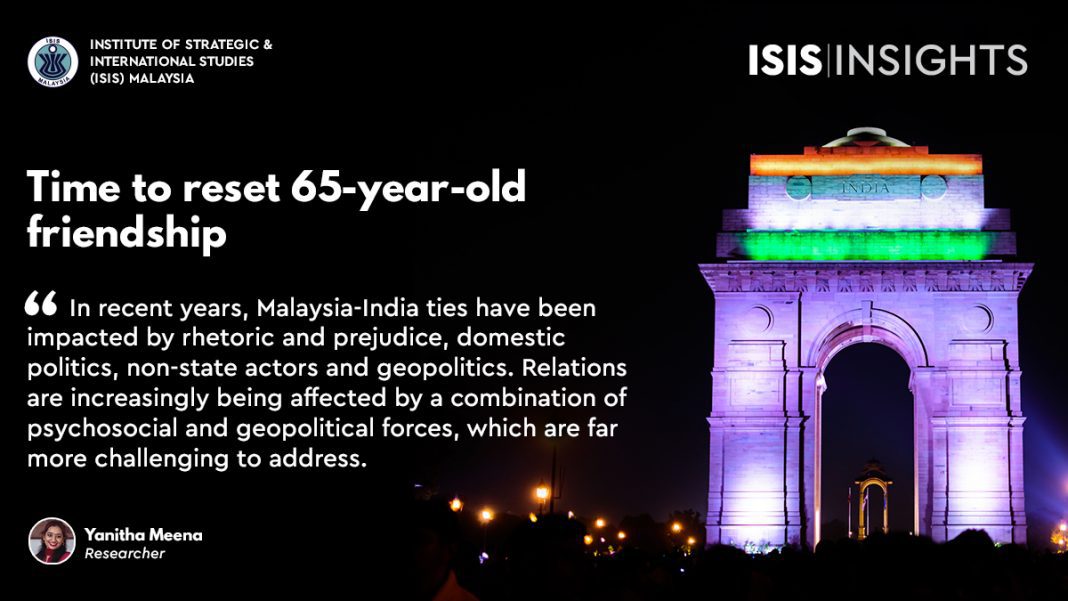Diplomacy, dialogues and deeper people-to-people ties to help overcome statis
AS we mark 65 years of Malaysia-India ties, a more sobering assessment of the bilateral relations is long overdue. Usually taken at face value as a “time-tested relationship”, crucial aspects of Malaysia-India ties have not transcended their traditional connotations and remain stuck in the past.
The diplomatic spat in 2019 laid bare brewing issues in the relationship. While diplomatic ties are back to being upbeat, this coincided with Malaysia’s change in government and pandemic-induced exigency. The root causes that prompted the spat have not been addressed.
Where does the Putrajaya-New Delhi relationship currently stand? Besides having elevated relations to an enhanced strategic partnership in 2015, Malaysia recently became India’s 13th largest trading partner while the latter consistently figures among the 10 largest trading partners for Malaysia.
Being Asean’s dialogue partner for three decades now, New Delhi also engages Putrajaya through the summit and working levels. However, it must be stressed that these do not reflect the true state of relations or actual potential of a six-and-a-half-decade partnership.
In recent years, Malaysia-India ties have been impacted by rhetoric and prejudice, domestic politics, non-state actors and geopolitics. Relations are increasingly being affected by a combination of psychosocial and geopolitical forces, which are far more challenging to address.
There are several contentious issues in the relationship. The respective political contexts and narratives of Putrajaya and New Delhi on the issue of the extradition of Indian televangelist Zakir Naik are a Pandora’s box of sorts. It is no surprise that this issue is currently on the backburner with the focus now on resuscitating bilateral relations. There is also a “trend” of people-led protests in Malaysia against certain political factions, domestic policies and statements and national stances in India.
While on the one end, the relationship is impacted because of domestic or national issues, the other end that is connected to geopolitics is equally complex. Like most Southeast Asian countries, Malaysia has its own set of challenges when navigating relations with China’s strategic competitors.
Whether it is on India’s Indo-Pacific Oceans initiative or even the QUAD, Putrajaya is careful with its posturing while maintaining an independent foreign policy approach. However, it is possible that in an attempt to take a balanced approach, it limits opportunities to deepen strategic cooperation with New Delhi.
What is the way forward? How can these complex challenges be addressed? For starters, through diplomacy and dialogue.
Policymakers in both Putrajaya and New Delhi already recognise the utmost importance of structured and enhanced dialogue in getting relations back on track. In April, the 5th foreign office consultations were held in Putrajaya. Both parties reviewed an entire gamut of bilateral relations and expressed optimism over a “faster revival of ties in the post-Covid period”.
However, dialogue cannot only take place at ministerial levels. Seeing how relations are also influenced by people-led movements, psychosocial factors and sentiments through a rather permanent bottom-up mechanism, dialogue cannot be “elitist”.
Here is an opportunity to include regular Track 1.5 dialogues with Indian and Malaysian think-tanks. New Delhi and Putrajaya should also support consistent Track 2 dialogues that include diverse groups and organisations. This will not only deepen people-to-people ties but also provide a platform for frank and open discussions, which will ensure a greater understanding of individual positions on contentious issues.
On a higher bilateral level in the current geopolitical context, there must be a mutual and conscious effort at trust-building bolstered by greater economic and non-traditional security interdependence. Putrajaya and New Delhi must understand each other’s national interests and priorities and work in niche areas indigenous to the relationship.
This could range from partnering to advance industries that rely on shared cultural practices or addressing shared pressing challenges, such as food insecurity. Capitalising on the strengths and similarities will reiterate the importance of ties in both countries.
The enhanced Malaysia-India partnership is an important tool that can be utilised to improve bilateral ties. But considering the shifting global and geopolitical contexts, it is time to review this framework and introduce initiatives and mechanisms that reflect current realities and priorities.
As we chart the way forward for the Malaysia-India partnership, it is important to realise that “time-tested” doesn’t mean “stagnant”. For Malaysia-India relations, diplomacy, dialogue and deeper people-to-people ties are the way forward. Clear intent, political will and fore vision will support these endeavours.





